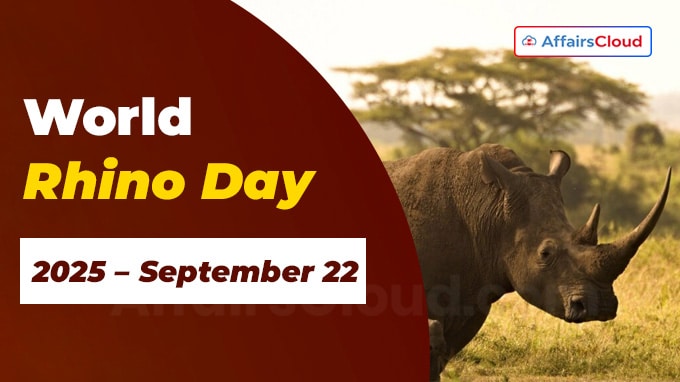 World Rhino Day is observed globally on 22 September every year to raise awareness about rhinoceros species (Rhinocerotidae) and emphasize the urgent need for their conservation.
World Rhino Day is observed globally on 22 September every year to raise awareness about rhinoceros species (Rhinocerotidae) and emphasize the urgent need for their conservation.
Exam Hints:
- Event: World Rhino Day 2025
- When? 22 September
- Origin: Initiated in 2010 by WWF – South Africa
- Founders: Lisa Jane Campbell (Chishakwe Ranch, Zimbabwe) & Rhishja Cota-Larson (Saving Rhinos, USA)
- First Observance: 22 September, 2011
- 2025 State of the Rhino Report (IRF): Global Population: ~27,000 rhinos; Black rhinos – 6,788; White rhinos – 15,752; Greater One-Horned – 4,075; Sumatran – 34–47; Javan – 50
- Notable Achievement: Sanjay Gandhi Biological Park(Bihar) – 2nd globally in rhino conservation.
History:
Origin: World Rhino Day was initiated in 2010 by the Worldwide Fund for Nature (WWF) – South Africa.
Founders: World Rhino Day was initiated through the efforts of two dedicated women conservationists: Lisa Jane Campbell from Chishakwe Ranch, Zimbabwe, and Rhishja Cota-Larson from Saving Rhinos, United States of America (USA).
First Observance :The first official World Rhino Day was celebrated in 2011, and it has been observed annually on 22 September since then.
About Rhino:
Mammals: Rhinos (Rhinocerotidae) are large, herbivorous mammals with thick skin and prominent horns, belonging to one of the oldest mammal groups.
Species: There are five living rhino species:
- White Rhino (Ceratotherium simum): Largest African rhino, second-largest land mammal after the elephant, also called Square-lipped Rhino, native to southern Africa.
- Black Rhino (Diceros bicornis): Smaller African rhino, also known as Hook-lipped Rhino, native to Africa.
- Greater One-Horned Rhino (Rhinoceros unicornis): Native to the Indian subcontinent.
- Javan Rhino (Rhinoceros sondaicus): Rarest large mammal in the world, also called Lesser One-Horned Rhino, native to Indonesia.
- Sumatran Rhino (Dicerorhinus sumatrensis): Smallest rhino species, only Asian rhino with two horns, native to Indonesia.
Habitat: Rhinos inhabit various ecosystems, including grasslands, savannas, forests, and swamps, depending on the species.
International Union for Conservation of Nature (IUCN) Red List: According to the IUCN Red List of Threatened Species:
- Black Rhino (Diceros bicornis), Javan Rhino (Rhinoceros sondaicus), and Sumatran Rhinos (Dicerorhinus sumatrensis) are listed as “Critically Endangered”.
- The White Rhino (Ceratotherium simum) species is listed as “Near Threatened”.
- The Greater one-horned rhino (Rhinoceros unicornis) species is listed as “Vulnerable”.
Ecological Role: Rhinos are considered “ecosystem engineers” because their grazing habits help maintain the structure of their habitats, benefiting other species.
Conservation Efforts: Project Rhino, launched in 2011 in Assam, coordinates efforts of all groups working for rhino protection.
2025 State of the Rhino Report:
Report: The ‘2025 State of the Rhino Report’ published by the International Rhino Foundation (IRF), indicates that rhino populations have remained stable, with no significant declines recorded over the past year.
Population Status: Rhino populations have stabilized at around 27,000 individuals globally.
- Black rhinos rose slightly to 6,788; white rhinos declined to 15,752, continuing a long-term decrease.
- Greater one-horned rhinos increased to 4,075; Sumatran rhinos remain critically low at 34–47; Javan rhinos fell to 50 due to illegal hunting.
Rhinos in India:
Species: India is home to the Greater One-Horned Rhino (Indian Rhino), mainly found in the north-eastern regions.
Famous Habitat: India is currently home to over 80% of the world’s Greater One-Horned Rhino population. Key habitats include Kaziranga National Park and Pobitora Wildlife Sanctuary in Assam, Orang National Park in Assam, Jaldapara National Park in West Bengal(WB), and Dudhwa National Park in Uttar Pradesh(UP).
- In 2025, Sanjay Gandhi Biological Park in Patna (Bihar) reached a major milestone by ranking second globally in rhino conservation, after the San Diego Zoo (the United States of America, USA). The zoo currently houses 10 rhinos.
About International Rhino Foundation (IRF):
The organization was founded in 1991 as the International Black Rhino Foundation and was renamed the IRF in 1993.
Executive Director(ED) – Nina Fascione
Headquarters- Texas, the United States of America(USA)




